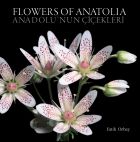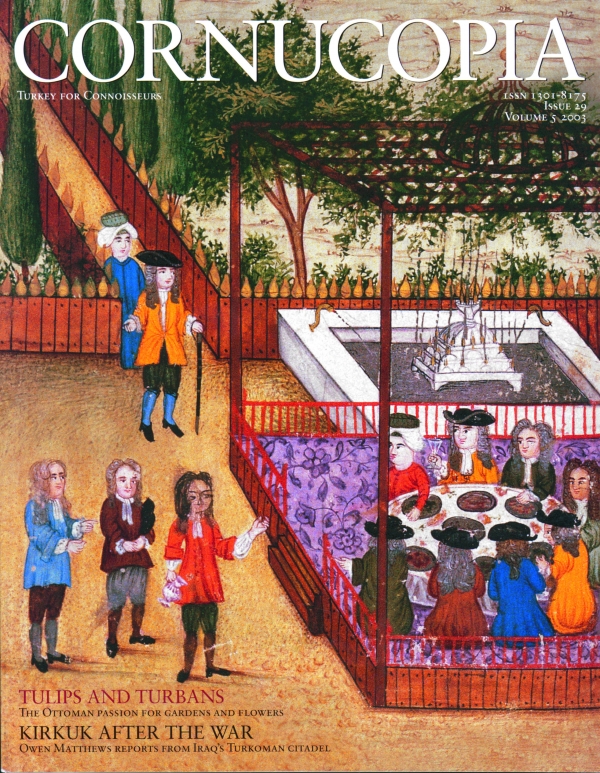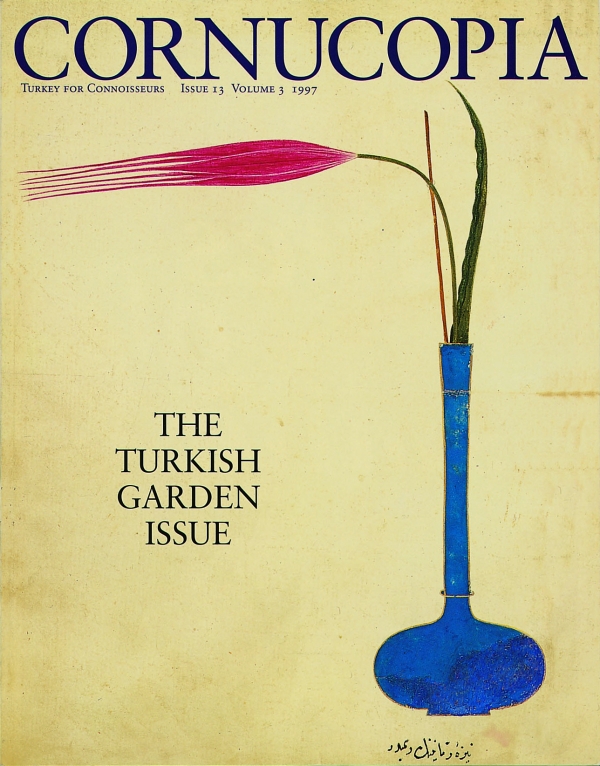Buy or gift a stand-alone digital subscription and get unlimited access to dozens of back issues for just £18.99 / $18.99 a year.
Please register at www.exacteditions.com/digital/cornucopia with your subscriber account number or contact subscriptions@cornucopia.net
Buy a digital subscription Go to the Digital EditionA Turkish-inspired garden on the Cambridge Fens. Two Turkish passions meet in the late John Drake’s beautiful garden: a love of symmetry and an abundance of wild flowers. Here the garden historian acknowledged his debt to the Turkish ideal of paradise on earth
For hundreds of years people have been laying out and enjoying gardens. Few stop to think why gardens were ever created and few gardeners have an overall philosophy for their creation. Gardens have been established to impress one’s friends, to grow a range of collected plants, to support a political idea, to establish “taste”, which often leads to fashions, to achieve an architectural extension from the house over the landscape, to create a setting for international events, to educate the public and even to encourage more paying visits to a stately home.
I can think of several more reasons, but my own garden philosophy is composed from several ideals, not least the need to pass on plants in order to save them from extinction. In England I garden in a windswept flat arable landscape denuded of hedges and hedgerow trees. The land was given to my parents as their wedding present, and they built their home, which stood for several years in a cornfield until I made a garden around their house.
In this landscape I wished to create a Paradise on earth, where as many plants as I could maintain would flourish. My student days had taken me to Padua to see Giotto frescoes. Luckily I discovered there the university’s botanic garden, where the circular plan incorporated formal flower beds representing the four known continents, all enclosed by a high circular stone wall. That summer flowers spilled everywhere and the space was a magical oasis from the blinding heat of the Po Valley and the traffic noise.
Jan Brueghel the Elder’s painting The Garden of Eden in the Victoria and Albert Museum epitomised for me the ideal of man, animals and birds living in complete harmony with each other. Overlaying a re-creation of the Garden of Eden on a formal geometric layout has been the driving influence throughout my gardening years.
Within a series of enclosed spaces connected by the narrowest of paths, I grow an extensive range of plants, many given to me by friends. In spring the formal layout disappears beneath bursting foliage which romps away until the November frosts. One elderly aunt enquires repeatedly, “When will your garden ever be tidy?” But if plants grow across paths or hang from tree branches, one must duck or step over them. The luxuriant foliage unwittingly forces one to return to the narrow path again and again for guidance.
These outside rooms with hedges for walls, against which roses are planted to imitate furniture, use tree canopies or the sky as elaborate ceilings. Each room has a different planting scheme – Turkish plants, or wild flowers in grass, or formal borders leading to a high-hedged enclosure tightly packed with plants available to gardeners in England before 1660.
My Turkish plants have been collected on my journeys as seeds in the wild, and they grow here among timber structures reminiscent of Seljuk* türbe* (tombs). I have now established Galanthus krasnovii (which I am proud to have rediscovered above Artvin), Cyclamen coum, Muscari armeniacum, tall nepetas and euphorbias among the Rosa ‘Kazanl›k’. Salvia argentea makes a good foil for Arbutus andrachnoides, and Geranium psilostemon grows through wild achilleas with finely cut leaves. The timber structures support Vincetoxicum nigrum, which has the tiniest chocolate-coloured flowers, hungry sweet peas, and a bronze form of Clematis orientalis from which I collected seeds while waiting for a bus in Yusufeli. Helleborus orientalis, with its white flowers, produces fresh green leaves that support stems of the orange Lilium artvinense, which I found on the summer pastures above Barhal. There is a great diversity of plants in Turkey which, if chosen carefully, can create fine displays.
I am constantly amazed at the flora that exists in Turkey, where plants from two adjacent continents meet. It is a botanist’s paradise. Yet Turkish gardeners seldom use plants that grow naturally in their own country. But then where in an English garden would you see wintersweet, lady’s smock, alexanders and corncockle?
Turks from the Anatolian plateau were never flower gardeners. The conditions and climate were too extreme. It was the Ottoman sultans who influenced garden trends from Mehmet II’s time onwards. We know something about Turkish garden philosophy from the French traveller and botanist Pierre Belon, who published Les Observations Singulières et Choses Mémorables in 1555. He recalls:
“The Turks now believe a thousand mad notions that Mohammed has given them to understand. Among other things, they believe that there are seven paradises…and that there are gardens planted with fruit trees, two or three of each kind, and that fountains and beautiful rivers run the length of the palaces, some flowing with pure milk, some with fine honey and others with sweet wine; and in the centre of paradise there is a great tree…whose leaves are of gold and silver…and inside each leaf appears the name of Mohammed after the name of God.”
Mehmet the Conqueror gave orders to plant 30,000 cypresses in a garden at Aynalıkavak. This site was established for the Sultan as a cool waterfront kiosk retreat from Topkapı along the northern shore of the Golden Horn. It lies beneath the Okmeydan (Archery Ground). It was here that vegetables and fruit were grown within the garden’s high walls for the Sultan’s table at Topkap›. A few of the original cypress trees survive, but interestingly Magnolia grandifloras introduced to Turkey in the eighteenth century also grow here – a sign that garden philosophy was accommodating plants from the West. It is vital that these Ottoman gardens are not allowed to disappear. Within their walls lie the clues to Turkish garden history.
Perhaps it is no coincidence that I have been asked to advise on the restoration of the garden at Aynalıkavak. Unwittingly I based my own philosophy on recreating a Paradise garden on earth long before reading that the Turkish sultans were intent on an identical philosophy.
SPECIAL OFFER: order five beautiful garden-themed issues, including this one, for only £80. List price £122*
In the 1950s, a palely beautiful summerhouse on the Bosphorus made tbe perfect playground for the cream of café society. Now its luminous, airy rooms, emptied of fuss and colour, reveal their natural beauty. Patricia Daunt uncovers the colourful past of Ratip Efendi’s yali.
When Ottoman sultans wanted to outshine European monarchs by the end of the sixteenth century they were choosing elaborate entertainments as their ammunition rather than solemn victory processions. In the second article in her series on East-West rivalry, Christine Thomson focuses on the Istanbul festivities of 1582, a spectacular street party lasting almost two months.
Some take the hard dusty route to the Mediterranean’s ancient sites. Christian Tyler approached them the hedonist’s way: cruising on a gulet along some of the most breathtaking coastline in the world.
Two isolated villages share an Ancient way of communicating across mountainous ravines. Andriëtte Stathi-Schoorel captures the last echoes in Greece and Turkey In Kuşköy (Bird Village), in the Eastern Black Sea Mountains, the ancient art of whistling is still taught to schoolchildren. It is in these very mountains, south of Trabzon, that Xenophon came upon a similar use of whistling nearly 2500 years ago. Only five communities in the world are known to share the ability to whistle their speech.
For thousands of years man has enjoyed the succelence of the grape. But the fruit is not its only gift.
More cookery features
One hundred and ninety years after the young Charlton Whittall first opened for business in Izmir, the members of this great dynasty are dispersed throughout the world. In June 359 descendants gathered at a reunion in London to celebrate the one thing that still inspires them all: their memories of life in Turkey.
An Egyptian rubbish heap reveals its buried treasure, mysterious birds deceive the eye, and Chinese clouds have silver linings. Philippa Scott continues her guide to the world of rug collecting







Cornucopia works in partnership with the digital publishing platform Exact Editions to offer individual and institutional subscribers unlimited access to a searchable archive of fascinating back issues and every newly published issue. The digital edition of Cornucopia is available cross-platform on web, iOS and Android and offers a comprehensive search function, allowing the title’s cultural content to be delved into at the touch of a button.
Digital Subscription: £18.99 / $18.99 (1 year)
Subscribe now